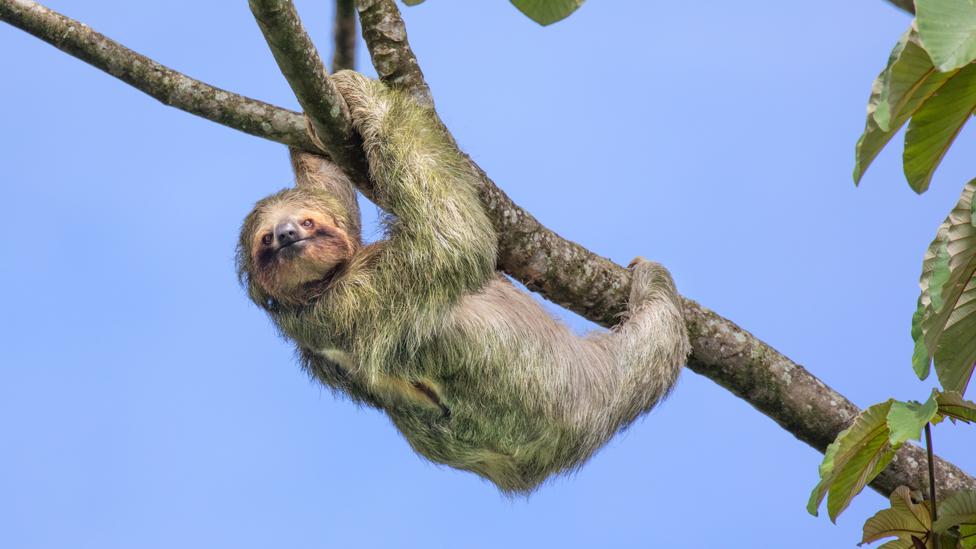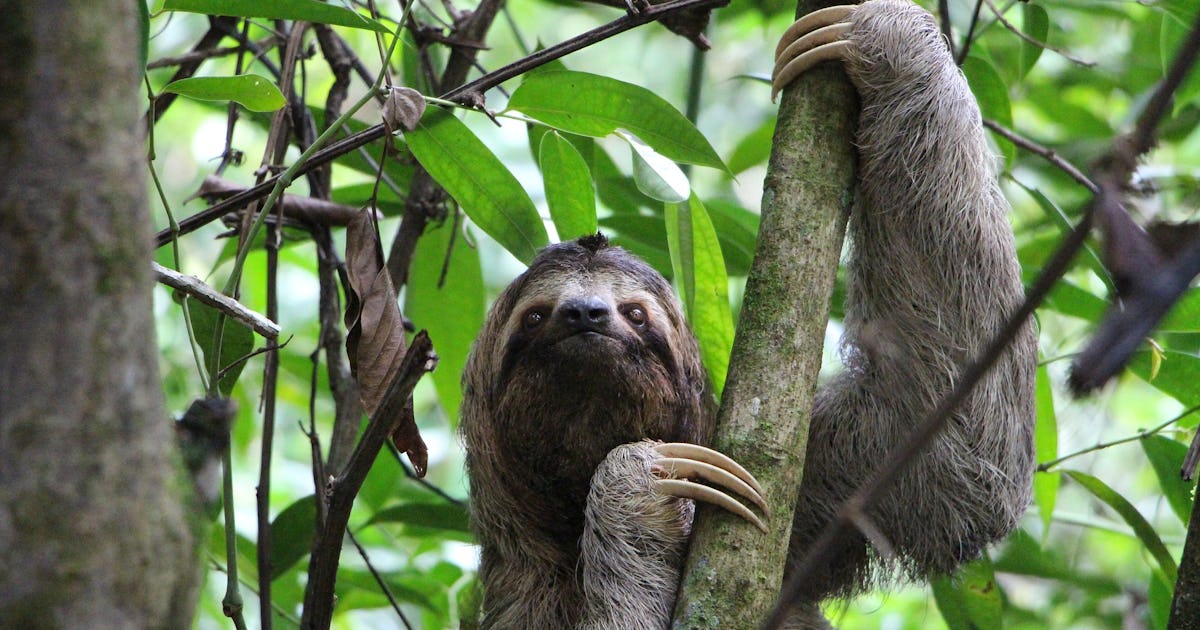How Sloths Move
Sloths are known for how slowly they move, but their slow speed isn't just a funny quality they have— it's part of why their species has survived for 64 million years. Following is the text of. Sloths move extremely slowly and survive on a low-calorie diet consisting only of leaves. Living an arboreal lifestyle has dangers — falling from trees can be lethal — but it offers protection.
Sloths are arboreal mammals that spend most of their time hanging upside down in the treetops. They belong to the order Pilosa and the superorder Xenarthra.
WHERE DO THEY LIVE?
In the tropical rainforests of Central and South America (in countries like Panama, Costa Rica, Colombia, Brazil, Suriname and Venezuela).
HOW MANY SPECIES OF SLOTHS EXIST TODAY?
There are six species divided into two families:
- Megalonychidae (the two-toed sloths)
- Bradypodidae (the three-toed sloths)


WHAT ARE THEIR NAMES?
- Hoffmann's two-toed sloth (Choloepus hoffmanni)
- Linnaeus two-toed sloth (Choloepus didactylus)
- Brown throated three-toed sloth (Bradypus variegatus)
- Pygmy three-toed sloth (Bradypus pygmaeus)
- Pale throated sloth (Bradypus tridactylus)
- Maned sloth (Bradypus torquatus)
WHAT DO THEY EAT?
They mainly feed on leaves, flowers and sometimes tropical fruits. The diets of two-toed sloths are much more varied than those of three-toed sloths.
HOW BIG THEY CAN GET?
Two-toed sloths are larger and heavier than their three-toed cousins: they can measure between 60 and 80cm, and their weight can range from 8 to 20lb.
The three-toed sloth can measure between 45 and 65cm, and weigh betweeb 5 and 10lb.
HOW SLOW ARE THEY?
Three-toed sloths typically move at a rate of around 7cm per second. Two-toed sloths, on the other hand, are a little faster. Sloths are expertly adapted to life in the canopy, and for that reason they struggle to get around on the ground.
Road traffic is the biggest threat to sloths, since it can take them up to five minutes to cross a road (and that's without stopping)! This is why habitat fragmentation is such a huge problem for them.
WHY ARE THEY SO SLOW?
Sloths have an extremely low metabolic rate, and this enables them to survive on relatively little food. It can take a sloth's body weeks to process something that another animal could digest in a matter of hours.
HOW MUCH DO THEY SLEEP?
Sloths can sleep for up to 18 hours a day, but not consecutively. They have a very low body temperature compared to other mammals - it ranges from 32 to 35 degrees Celsius.
In cold conditions, sloths struggle to regulate their body temperature. This is because of their reduced muscle mass - this makes it hard for them to increase their metabolic rate.
HOW LONG CAN THEY LIVE?
Between 20 and 30 years.
DO THEY HAVE PREDATORS?
Sloths use their sharp claws to defend themselves, but their slow movements and excellent coat of camouflage help them slip under the radar of passing predators. Their natural predators include snakes, jaguars, harpy eagles, coyotes and other carnivores, but their biggest threat today is habitat loss.
DO THEY HAVE ANY THREATS?
One of the biggest threats that wild sloths face is forest fragmentation, a result of habitat destruction. Sloths usually travel through the treetops, but thanks to the expansion of urban areas and road networks, gaps in the canopy are being encountered by sloths more frequently. When faced with this sort of obstacle, a sloth has no choice but to climb down to the ground, where it becomes extremely vulnerable to predators. Sloths will often attempt to cross roads and busy highways, and this is where the vast majority are killed unless a generous person helps them across.
Habitat fragmentation is turning once vast, well-connected patches forest into tiny 'islands' surrounded by oceans of asphalt and concrete. Some sloth populations become so isolated that inbreeding occurs, resulting in all sorts of health problems caused by genetic deficiencies.
Sloths are some of the most fascinating creatures that are on the planet today. Many people know about how slow sloths tend to move. Some move so slow that moss can actually form on their fur. We can all learn a lot from these amazing creatures, so here are some interesting facts that you may not have known about them.
1. They’re Not Always Slow
Recent studies have shown that sloths are actually twice as active as people have perceived them to be. Most sloths will sleep for less than 10 hours per day and although they won’t travel long distances, if you’ve every seen a sloth climb a tree, you know that they can be pretty speedy when they choose to be.
Smooth Moves Sloth
2. Death Has No Grip
Sloths are known for their grip, which is so strong that it is even retained after the sloth has died. This is because of the intense muscle memory and development that occurs within the sloth over the course of its life. Because it has to hold onto tree limbs every day to maintain the balance of life, the grip doesn’t always release, even when there is no mental input telling it to keep hanging on.
3. How Many Toes?

Even two-toed sloths actually have 3 toes. The reason why the two-toed sloth got its name is because it only has two claws on its forelimbs instead of the standard three. It would be more accurate to call the two-toed sloth a “two fingered sloth,” which is actually what its original named happened to be from its Spanish discoverers.
4. It’s a Portable City
Many sloths have algae within their fur that regularly grows. It’s a symbiotic relationship that the sloth has with the algae, making it a portable city that helps to camouflage the animal during the growing season and provide food for local moth populations.

How Fast To Sloths Move
5. A Horror Movie In the Works
Some sloths can almost turn their heads around completely. We’re talking about a full 360 degree turn here. Imagine standing behind a sloth and having it turn just its neck so that it could stare you down. That can actually happen with certain species.
How Fast Do Three Toed Sloths Move
6. It’s the Metabolism, Silly
The reason why sloths tend to move slowly on most occasions is because their metabolism is extremely slow. It takes a long time for a sloth to digest the food that is eaten, which means a sloth has to eat a lot in order to get the slow trickle of vitamins and minerals that they need. This slow digestion process also means that the average sloth only needs to go to the bathroom just once per week.
Sloths have not always been seen as cute, awesome, or even useful. When they were first discovered, the average observer thought them to be quite ugly and useless. It’s probably a good thing that these initial discovers weren’t around when the Giant Sloths were roaming the Earth! We can learn a lot from these cool creatures and these facts are just a start.